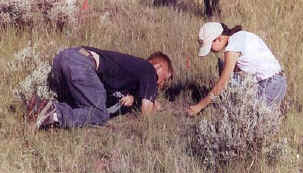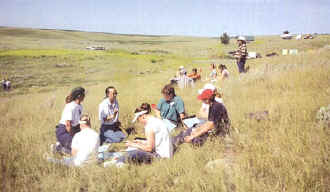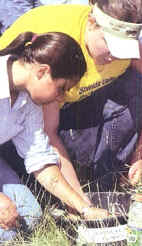|
Montana
Range Days
Tomorrow's
ranchers
have fun
while
exploring
science from
the ground
up.
Story
and photos
by Tom
Daubert
Grazing
cattle are a
common part
of the
scenery on
rangelands
around
Malta, Mont.
But on the
third week
in June,
instead of
cows,
there'll
be small
groups of
children
roaming the
grasslands.
Hundreds of
them, ages
four through
high school,
will gather
in clusters,
grouped by
age. At
times
they'll
separate,
strung out
in lines
across
hillsides.
Some will
crouch down,
inspecting
plants and
making
notes.
Later, a
whistle will
blow, and
the kids on
one hill
will trade
with those
on another.
But for the
sound of
wind and
breeze, and
the
occasional
whistle
telling them
to move to
the next
station,
there will
be silence
all morning.
This
is the final
morning of
"Montana
Range
Days."
Long after
the regular
school year
has ended,
when most
could be
playing with
friends back
home, these
children are
taking a
test. But it
isn't a
formal
school and
it isn't
at all
boring.
Instead,
it's three
days busy
with
learning,
combined
with fun and
entertainment
for the
whole
family.
Now
in its 28th
year, this
annual event
for ranch
families-and
especially
for their
children-teaches
the science
that
underlies
modern-day
ranching.
Every two
years the
event moves
to a new
location.
Over time,
this makes
it possible
for Montana
Range Days
to be a
relatively
local event
a few times
during the
childhood
and
adolescence
of virtually
every young,
future
rancher in
Montana.
Malta hosts
the event
for a second
time this
year, and in
2005 Montana
Range Days
will start a
two-year
stint based
in Park
County's
Livingston.
"Land
management
practices
should be
based on
science, not
emotion,"
says Taylor
Brown of the
Northern
Broadcasting
System
(which many
Montanans
refer to as
the
"Northern
Ag
Network").
"That's
what Montana
Range Days
is all
about,
helping the
next
generation
of ranchers
learn the
things
they'll
need to
know. When
these kids
graduate
from high
school,
they'll
know more
about this
stuff than I
did as a
college
graduate."
Brown
knows what
he's
talking
about. He
was involved
when Sam
Short, a
range
conservationist
with the
USDA's
Soil
Conservation
Service,
founded the
first
Montana
Range Days
back in
1977. For
the past 24
years,
Brown's
radio
network has
been the
primary
sponsor of
the program,
working with
the
volunteers
in local
host
conservation
districts
across the
state.
"Look
at this,"
he exclaims,
pointing to
children
grouped on a
hill in the
distance.
"These
kids could
be anywhere
else right
now. But
instead they
choose to
have this
kind of fun,
learning
about plants
and range
and grazing
management.
It's just
tremendous."
Brown's
enthusiasm
could be
called
infectious,
except for
the fact
that over
the course
of a weekend
observing
the
goings, on,
it becomes
clear that
it is the
fun and
camaraderie-the
experience
of Range
Days
itself-that
feeds its
participants'
excitement.
It
begins on a
Monday
afternoon as
cars,
pickups and
vans from
all over the
state
converge at
Malta High
School. A
field next
to the
school
auditorium
quickly
turns into a
campground
filled with
tents for
children
aged four to
84. (Most
are in their
teens.) Many
greet
friends from
across the
state whom
they
haven't
seen since
last
year's
Range Days.
A
few miles
down the
road, the
event's
teachers and
organizers
have turned
a hillside
into an
outdoor
identification
laboratory,
where flags
mark the
variety of
range plants
the students
will learn
more about
this week.
As evening
approaches,
busloads of
parents and
children
visit this
area, to
begin
learning how
to identify
the plants
they may not
have
encountered
yet back
home. Later,
everyone
converges
back at the
high school
for a
barbeque. It
is soon
after eating
that the
first formal
event of the
program
begins: a
range-related
public
speaking
competition
involving,
generally,
the older,
high
school-aged
students
giving
"illustrated
talks"
complete
with
PowerPoint
presentations.
After
breakfast on
Tuesday,
participants
break into
groups based
on age.
"Beginning
Buckaroos"
are the
youngest and
smallest,
ranging from
four to
eight. Then
there are
the
"Superstarters"
(ages 9-11),
the
"Wranglers"
(ages
12-13),
"Youth"
(ages 14-19)
and
"Adult."
After a
brief
orientation,
everyone
loads onto
buses that
take them to
the day's
outdoor
school, a
nearby ranch
that has
donated its
pastures for
the purpose.

Here,
all morning
and
afternoon,
the students
attend a
series of
revolving
outdoor
workshops on
subjects
central to
smart,
science-based
ranching.
The
workshops
are tailored
to the
different
age groups,
with the
most
sophisticated
sessions for
the older
groups. One
group learns
about plant
anatomy
while
another
focuses on
plant
identification;
one group
learns how
to inventory
and monitor
a
pasture's
vegetation
while
another
learns how
to determine
sustainable
stocking
rates on a
particular
pasture, or
how to
assess the
nature of a
site's
soils and
how soil
types should
affect
livestock
management
decisions.
The
teachers are
experts-and
most all of
them are
volunteers-from
agencies
like the
Natural
Resources
Conservation
Service, the
Bureau of
Land
Management
and Montana
State
University-Bozeman's
Animal and
Range
Science
Department.
At noon, all
the teaching
temporarily
stops for a
special lamb
barbeque
that the
organizers
have
prepared
with roasts
and supplies
donated by
local
ranchers and
businesses.
In Malta,
Range Days
has become a
community-wide
event, with
the only
local radio
station in
the county,
KMMR-FM,
talking
about it all
weekend and
inviting
everyone to
attend the
Tuesday
evening
banquet.

Students
learn how
cattle use
range
plants, how
to manage
land
and
identify
plants. They
gather in
small groups
developing
grazing
plants.
Assessing
pasture
health
includes
digging in
the
dirt and
learning
how
the soil
works by
pouring
water on the
soil and
kneading it
like bread
dough.
That
night, the
banquet
draws a
large crowd,
and is
followed by
a hoedown
dance for
the kids and
their
parents.
Organizers
this year
are hoping
for weather
as nice and
cloudless as
it was in
2003, to
allow for
dancing
under the
stars after
a busy day
at
"school."
After
Wednesday's
breakfast
and another
quick
assembly,
everyone
again loads
onto buses
for the ride
to the
previously
undisclosed
Range
Days'
testing
grounds.
Here, on
pastures the
participants
haven't
seen before,
they again
find flags
marking
plants
they're
asked to
identify.
Other
stations in
the process
test what
they've
learned
about soils,
stocking
rates and
other issues
of
importance
to ranching
success.
Most of the
morning is
spent this
way,
children
excitedly
moving from
one test
location to
another,
completing
their score
sheets in
silence
under the
watchful
eyes of
adults who
monitor the
contests. As
the sun
rises and
the day's
warmth
builds, a
table with
cookies and
refreshments
becomes a
steadily
more popular
stopping
place.
And
then, the
testing
period comes
to an end,
and the
buses again
take
everyone
back to the
high school
for lunch.
The
climactic
event is an
awards
ceremony.
There are
winners in
every age
group,
"but
everyone
here is a
winner,"
one parent
says, and
her daughter
agrees:
"We have a
lot of fun
here. The
whole thing
makes
learning
fun."
The
adults seem
to have at
least as
good a time
as their
children.
Besides the
fulfillment
of watching
kids enthuse
about the
science of
ranching,
Montana
Range Days
offers
adults
day-long
tours that
are
entertaining
and
interesting
in their own
right. With
Malta being
a virtual
capital of
Montana's
dinosaur
country, one
tour focuses
on area
dinosaur
digs and the
local
museum,
whose
paleontologic
displays
rival those
of major
American
cities.
Phillips
County also
borders
historically
important
Lewis and
Clark
country; the
Corps of
Discovery
came through
on the
Missouri
River near
here roughly
199 years
before this
year's
event.

One
thing all
the kids
learn
quickly is
the value
of
getting down
on all fours
to inspect
plants
closely,
to
see them the
way cows do.
In
the year
2105,
Montanans
will
celebrate
the
tercentennial
of the
passage of
Lewis and
Clark. Will
Montana
Range Days
then be
celebrating
its 129th
year? Those
who have
attended
would be
likely to
answer with
a qualified
"yes."
They might
say that if
ranching
itself
survives to
the year
2105, the
odds are
high not
only that
Range Days
will still
be
ongoing-but
that it was
Range Days
that played
a
significant
role in the
survival of
Montana
ranching.
Tom
Daubert is a
writer based
in Helena,
Mont. To
learn more
about the
2004 Montana
Range Days
in Malta,
June 21-23,
check for
informational
updates on
the Internet
site, http://www.MontanaRangeDays.com,
call the
Malta USDA
office:
406-654-1334,
Ext. 3, or
e-mail pat.anderson@mt.usda.gov.
Summer
2004
Contents
|

